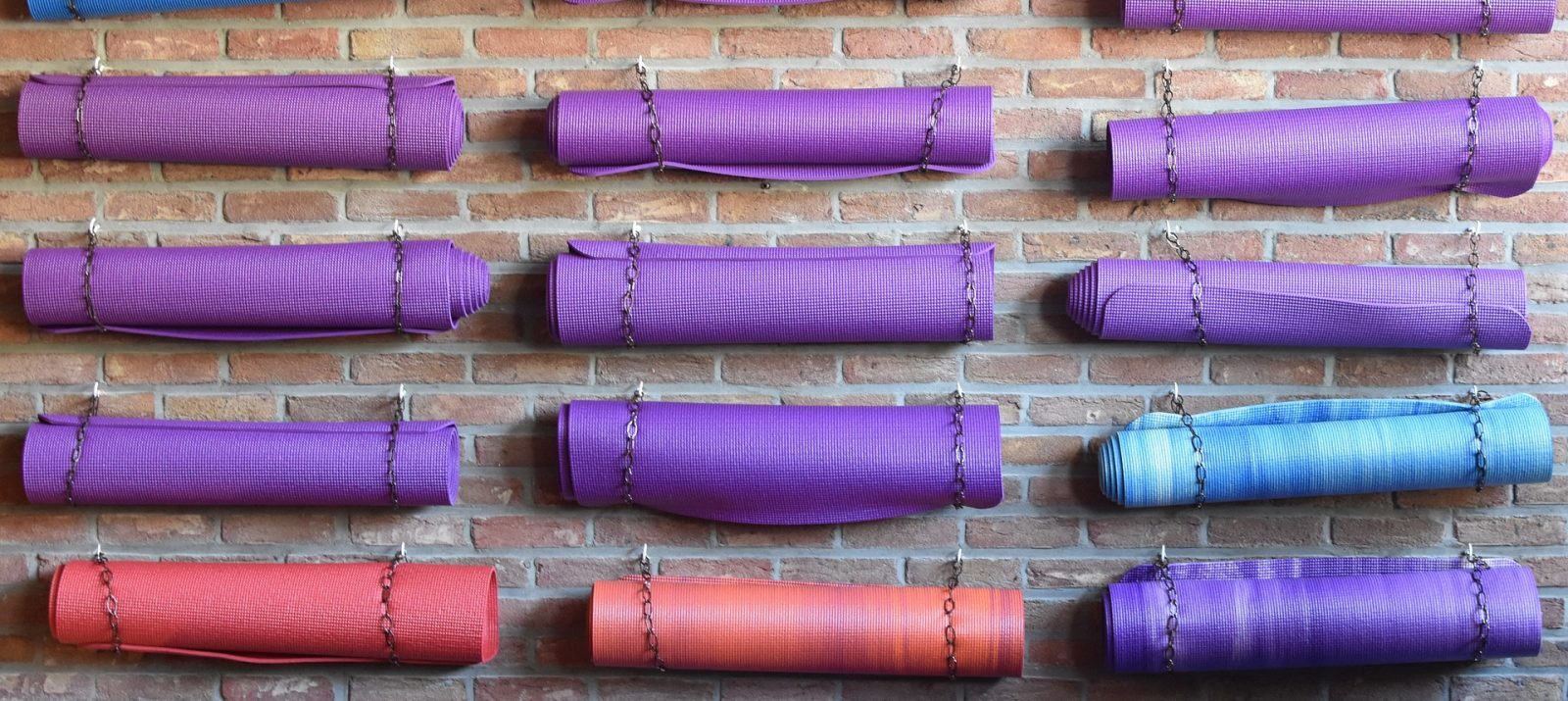You already know that yoga helps you achieve a clear state of mind as you kickstart your morning, and recharge after a hard day’s work. But did you know that not properly cleaning your yoga mat exposes your body to more bacteria than a toilet seat, cell phone, and an airline seat combined?
We didn’t know that either. Until we did some research, and asked yogis and yoga teachers how we should be cleaning and storing our yoga mats so that they last longer, smell less, and don’t harm our health.
Turns out, tossing a yoga mat in a washing machine and dryer, and then leaving it rolled up in a closet is a bad idea.
Ready to Declutter? Trust Clutter to Safely Pack and Move Your Yoga Gear!
Why It’s Important to Clean Your Yoga Mat
Maintaining Hygiene: After a yoga session, your mat can become a haven for bacteria, fungi and other germs especially when sweaty. Cleaning your mat regularly is essential to eliminate these harmful microorganisms and ensure you have a clean, safe surface to practice on.
Prolonging the Life of Your Mat: Your yoga mat takes a lot of wear and tear over time from sweat to dirt buildup. Regular cleaning helps maintain the material’s integrity so your mat stays supportive and functional for longer.
Improving Grip and Stability: A clean mat provides better traction which is crucial in maintaining balance during poses without falling off. Dirt and sweat can make your mat slippery thus enhancing the risk of injuries while also hindering your practice.
Eliminating Unpleasant Odors: No one wants to unroll a smelly yoga mat. Sweating together with bacteria causes bad smells but cleaning it up regularly ensures that it remains fresh for the next session.
Protecting Your Skin: Direct contact with dirty yoga mats can lead to skin irritations or infections. Keeping your mat keeps it quite comfortable while protecting skin too
Types of Yoga Mats and Cleaning Methods
PVC Mats: These mats are durable and can be washed quite easily. Use mild soap solutions and warm water to wipe them off. Keep away from strong chemicals that may destroy the material, thus reducing its life span.
Rubber Mats: Made of natural rubber, these eco-friendly mats have good grip; however, they need careful handling. Clean them with water mixed with vinegar or you can buy special rubber mat cleaning solutions. They should always be air-dried but shielded from direct sunlight because the sun may cause cracks to appear on their surface.
TPE Mats: Thermoplastic elastomer mats are environmentally friendly and hypoallergenic . For keeping their environmental features intact, clean them using a weak non-alcohol alcoholic solution . Avoid scrubbing aggressively as it destroys the surfaces of the mat.
Cotton Mats: In traditional practices , cotton mats can be machine washed gently with cold water only . After washing, air dry your mat to avoid it shrinking and keep its natural feel .
Jute Mats: Made of natural fibers jute mats are sustainable and provide good traction for your feet. Wash these items by hand using mild detergent and water is a simple instruction that diligently followed will keep this rug in perfect condition for a long-time . Be cautious about soaking the rug since too much water weakens the fibres lessening durability .
What You Need to Clean a Yoga Mat
Mild Soap or Detergent: This is the main ingredient in any cleaning solution. It effectively takes out dirt and dust without destroying the mat’s quality. Opt for a mild soap that does not contain harsh chemicals.
Vinegar: For most types of yoga mats, white vinegar is a mild natural disinfectant that can safely be used to clean them. It exterminates bacteria while maintaining the mat clean and fresh since it does not contain harsh chemicals.
Water: Cleaning agents need to be diluted using water and rinsed off the mat afterwards. Always use lukewarm and clean water to avoid leaving any unwanted residues on your mat.
Soft Cloth or Sponge: A gentle cloth or sponge is used to scrub away sweat and dirt from a mat without ruining it; don’t employ the abrasive pads as they wear down its surface area.
Essential Oils (Optional): To your cleaning solution, you may add several drops of essentials oils such as lavender or tea tree oil, which will give you a sweet smell; these are known for their antibacterial properties alongside making sure your mat smells nice and feels great.
Here’s how to clean, dry, and store yoga mats like an expert:
How To Clean Your Yoga Mat
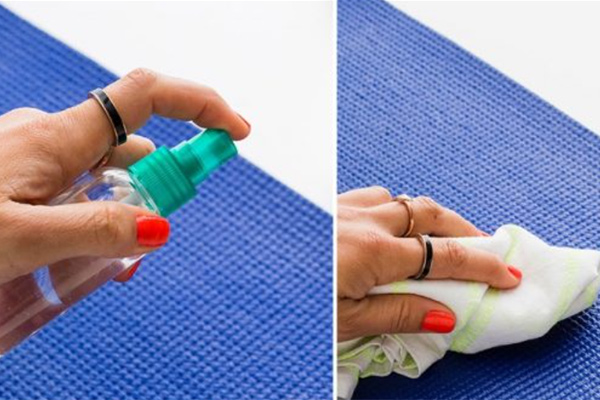
Yoga allows for detoxification of the mind, body, and spirit. Great for overall clarity, but your sweat has to go somewhere, and that somewhere is usually straight onto your mat.
Cleaning your yoga mat — including accessories like yoga blocks, bolsters, and towels — eliminates any bacteria that could accumulate.
The result: A healthier you, and a longer lasting mat.
“To get the most out of your yoga mat, always follow the manufacturer’s directions for cleaning,” says April Thompson of CorePower Yoga in Chicago’s South Loop. “Materials used in yoga mats may differ from brand to brand.”
Since nearly every part of your body touches your mat at one point or another during a yoga class, be sure to use an all-natural cleaning product that won’t harm your body or health.
After each class, experts recommend giving your mat a quick rub down with Yoga Mat Refresher wipes like these from Stirlen:
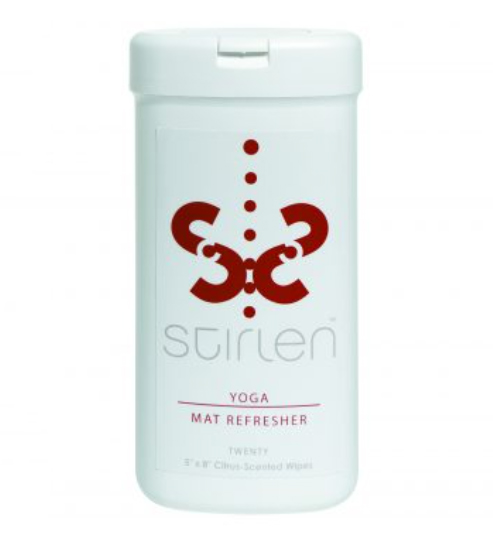
Stirlen’s yoga mat refresher wipes will quickly remove any sweat and dirt that may have accumulated as you flowed from pose to pose. Which means you’ll spend less time cleaning and more time adventuring.
Practice yoga at home or have a bit more time after arriving back from a class?
Wipe down your mat and blocks with a damp cloth followed by a dry cloth or paper towel. While this method may not entirely remove germs and bacteria, you’ll keep the residual grime at bay until you can give your gear a deeper cleaning.
A store-bought cleaner spray, like this 100% All Natural Yoga Mat Cleaner from Asutra (pictured below), is an organic blend of ingredients including coconut oil, rosemary extract, and tea tree essential oils that won’t leave any residue.
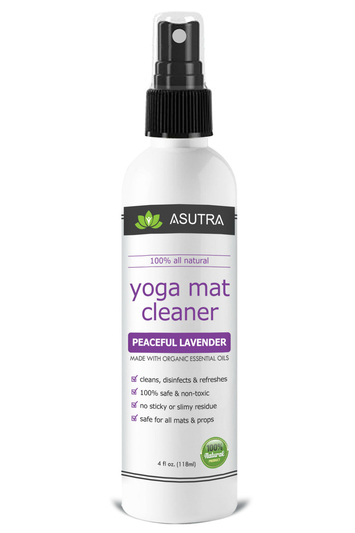
Even better, Asutra’s yoga mat cleaner spray comes in a variety of calming scents like Energizing Peppermint, Uplifting Eucalyptus, and Peaceful Lavender. It also includes a handy microfiber cleaning towel that’s lint-free, super absorbent, and small enough to fit in any yoga bag.
Looking to flex your DIY muscles?
You could spend 10 minutes searching Google for the best homemade yoga mat cleaner recipe. Or you could spend a couple of seconds praising our friends at Brit + Co who already did the homework for you. Here are Brit + Co’s two recipes for DIY yoga mat cleaning sprays.
One recipe is for non-slip mats and is made of white vinegar, distilled water, and lemon. Their second recipe is for non-porous mats and calls for distilled water, witch hazel, and essential oils:

For mats that require more intensive care, a trip to the bathtub is in order. The easiest mess-free way to wash your yoga mats and accessories is to lightly scrub them with mild soap, and then rinse them thoroughly under a showerhead or faucet.
You’d be surprised how much dirt you’ll see wash down the drain! This meticulous clean only needs to be completed once a week, or less if you’re not yet a hardcore yogi.
How To Dry Your Yoga Mat
Aqua Yoga has a place, and it’s in a pool, not on a still-damp mat. If you don’t allow your mat to fully dry after washing, it can lead to bacterial growth and the formation of mold and mildew. Fun.
Give your mat adequate time to dry (at least an hour or overnight) by hanging it on a drying rack, a shower curtain rod, or the back of a chair. Outdoor yoga is great for boosting your mood and becoming one with the elements, but it’s not the best option for airing out your gear following a strenuous Ashtanga sesh.
“Although the sun’s rays are considered a natural drying agent, they can be harmful to many rubber mats, causing them to decay faster,” says Thompson. To prolong the life of your mat, don’t leave it outside to dry for an extended period of time. Move your mat indoors at the end of your practice.
How To Store Your Yoga Mat
Rolling up your mat length-wise while on-the-go is the easiest method of packing it up. But back in your apartment, the ideal approach is to let it hang or lay flat.
An empty corner of the room where your mat can spread out — away from pets or curious kids or roommates with sticky hands — will suffice.
Prefer to keep your mat out of the way?
Here are five yoga mat storage solutions that will keep your mat safe and in good condition:
Namatse Yoga Mat Hanger
If you’d rather keep your mat unrolled but don’t trust leaving it flat on the ground, this solution offers the best of both worlds.
DIY Yoga Mat Rack
Free up floor space with a functional wall-mounted rack that keeps your mat clean and easily accessible.
Many wine racks and towel racks can double as perfectly-sized storage for your yoga mat. Or you can DIY a yoga mat rack with this easy-to-follow yoga mat rack guide from Gray House Studio.
Yoga Mat Basket

A sturdy and stylish basket can hold multiple mats at once and lets you display them out in the open. Because nothing says, “Hey everyone, check out how Zen I am” than a neat arrangement of yoga gear.
Yoga Mat Bag
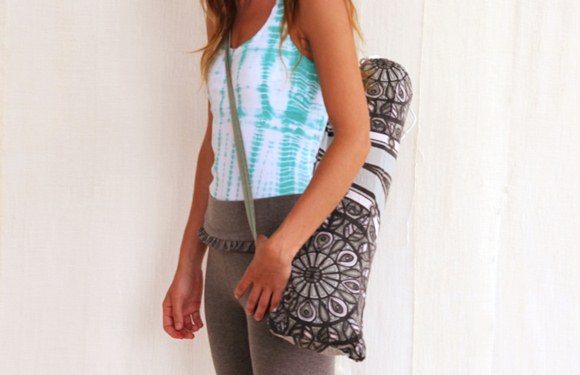
Tight on space and time?
Store your yoga mat in a cute carrying bag with a strap, and hang it on a wall-mounted hook in your entryway. Doing so is smart for two reasons:
- You’ll save a decent amount of floor and closet space.
- You won’t forget where you stashed your yoga mat because it’ll be right in front of your face as you exit the door.
Make your own yoga mat carrying bag with this simple tutorial from Free People.
Clutter
Going on a three-month yoga retreat around the world? Have extra yoga mats and accessories eating space in your closet?
Grab your yoga mat and accessories, clean them with refresher wipes, and leave the rest to Clutter.
Simply schedule a pickup and pack up your yoga straps, mats, blocks, and wedges. We’ll take it all to our secure, temperature-controlled storage facility and create an online photo catalog of everything so you never forget what you have in storage.
When you return in a supreme state of self-awareness and want your yoga gear back, you don’t have to trek to a self-storage unit way across town. The only thing you actually have to do is log into your MakeSpace account, click the photos of the items you’d like back, and we’ll deliver them right to you.
Why waste positive energy, time, and money on frustrating self-storage when you can waste nothing on stress-free Clutter?
Yoga Mat Care: Pitfalls to Dodge
- Chemical Warfare: Ditch those harsh cleaners. They’re mat-killers, stripping away the grippy surface and leaving behind a slick, irritating residue. Stick to gentle, natural solutions.
- The Bathtub Mistake: Don’t dunk your mat. It’s not a sponge! Soaking leads to a soggy core, creating a breeding ground for mold and bacteria. Your mat will stink and deteriorate rapidly.
- Machine Mayhem: The washing machine is your mat’s worst enemy. The agitation and heat will tear it apart, leaving you with a warped, useless mess. Hand-cleaning is the only way to go.
- Scrubbing Frenzy: Easy on the elbow grease! Aggressive scrubbing wears down the mat’s texture, ruining its grip and shortening its lifespan. Gentle circular motions are all you need.
- UV Overexposure: Sun-drying seems bright, but more UV is needed. Prolonged exposure fades colors and breaks down materials, especially natural rubber. Your mat will end up brittle and prone to cracking.
Preserving Your Mat: Smart Upkeep Strategies
1. Post-Practice Wipe-Down: Make this a habit. A quick pass with a damp microfiber cloth removes sweat and skin oils, preventing buildup. Focus on high-contact areas like hand and foot positions.
2. Deep Clean Ritual: Give your mat a thorough cleansing once a month. Use a mild soap solution and work it in with a soft cloth. Rinse thoroughly and pat dry – no soap residue left behind.
3. Proper Drying Technique: After cleaning, hang your mat over a shower rod or drying rack. Ensure good air circulation and avoid direct sunlight. Patience is vital – wait until it’s bone-dry before rolling up.
4. Strategic Storage: Keep your mat in a cool, dry place, away from heat sources and humidity. Avoid cramped, damp spaces like basements. Store it flat or loosely rolled to prevent permanent creases.
5. Sweat Management: Invest in a good mat towel for hot yoga or intense sessions. This absorbent layer protects your mat from excessive moisture and extends its life considerably.
Keep Your Yoga Space Organized! Let Clutter Handle the Rest.
Conclusion
Your yoga mat is the foundation of your practice. Treating it with care isn’t just about longevity but respecting your yoga journey. A well-maintained mat provides the stability and comfort to push your limits and find your zen. With proper attention, your mat will support you through countless flows, providing a reliable surface for growth and self-discovery.Roll out a clean, fresh-smelling mat and feel the difference in your practice. Your body will appreciate the hygienic surface, your nose will thank you, and your mat will reward your efforts with years of dependable performance. Now, center yourself, take a deep breath, and step onto your pristine yoga companion for your best session yet.
FAQs for How To Clean yoga mat
Q: How frequently should I clean my yoga mat?
A: It’s recommended to clean your yoga mat after every few uses, especially if you practice regularly. A thorough cleaning once a week helps maintain hygiene and keeps the mat in good condition.
Q: Can I use essential oils to clean my yoga mat?
A: Yes, essential oils can be used, but it’s important to dilute them properly with water. Oils like tea tree or lavender have natural antibacterial properties, making them great for refreshing your mat. However, avoid using too much oil as it might make the mat slippery.
Q: How can I effectively clean a yoga mat that feels sticky or tacky?
A: For a sticky or tacky yoga mat, a mixture of water and mild soap can help. Gently scrub the mat with a soft cloth or sponge, then rinse thoroughly with clean water. Allow the mat to air dry completely before rolling it up or storing it.
Q: What’s the most effective way to eliminate odors from my yoga mat?
A: To remove odors, sprinkle baking soda on the mat and let it sit for about 15 minutes before wiping it off with a damp cloth. You can also spray a mixture of water and a few drops of essential oils, like eucalyptus or lemon, to keep your mat smelling fresh.
Q: Is it okay to store my yoga mat immediately after cleaning it?
A: No, it’s best to let your yoga mat dry completely before storing it. Storing a damp mat can lead to mold and mildew growth, which can damage the mat and cause unpleasant odors.


